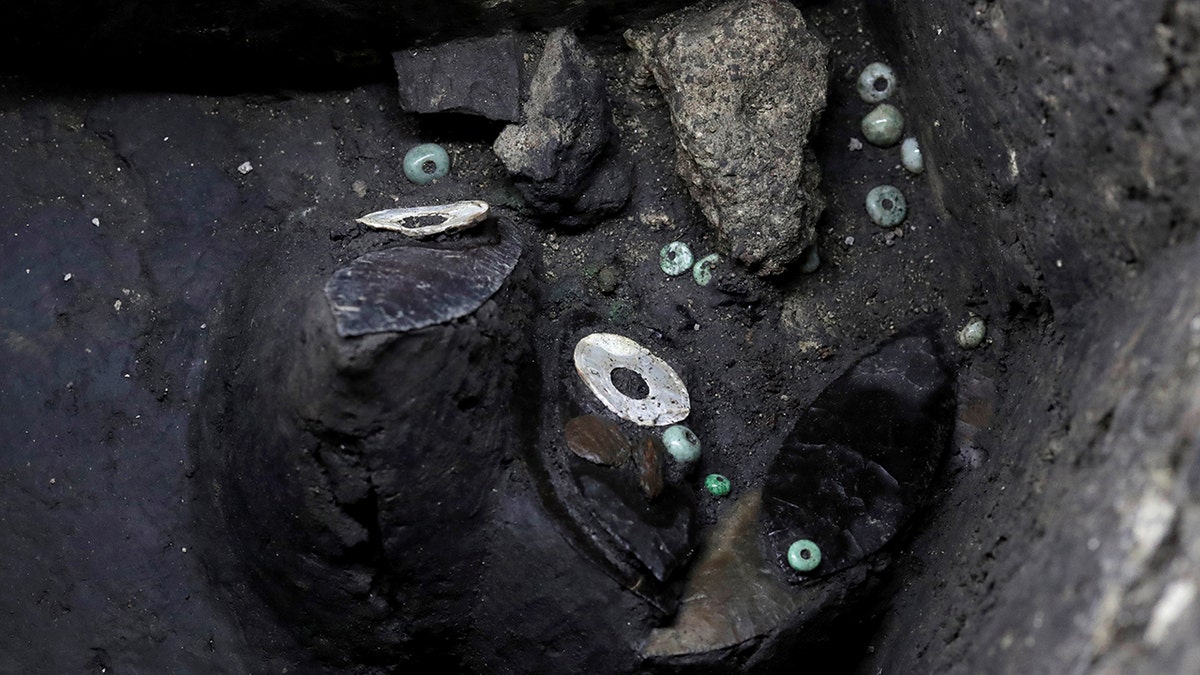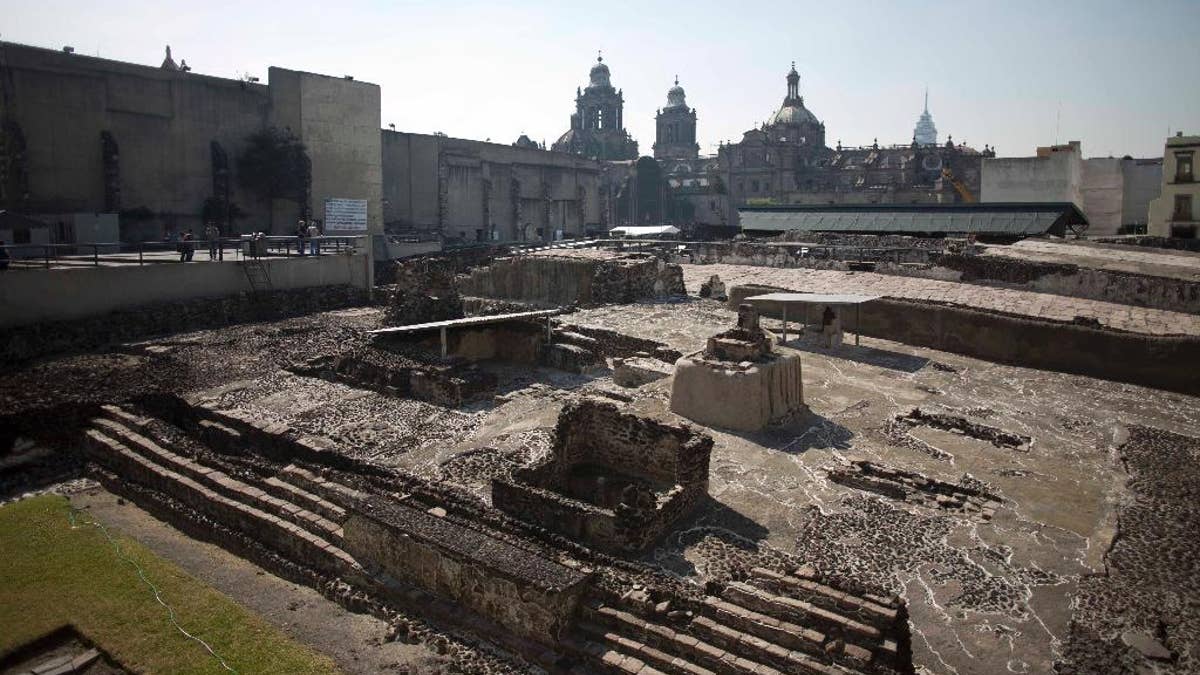
Tomas Cruz, an archaeologist with the National Institute of Anthropology and History (INAH), works at a site where the 500-year-old interior of a partially-excavated stone box contains an Aztec offering that includes the bones of a jaguar with the circular emblem of the war god Huitzilopochtli, as well a layer of coral, the remains of a large number of starfish and shells. (REUTERS/Henry Romero -)
Archaeologists have made a grisly discovery in Mexico City that could lead to the first-ever Aztec royal tomb, according to Reuters.
Experts found an array of sacrificial remains during an excavation at the base of the Templo Mayor temple site in downtown Mexico City. Reuters reports that the finds include the body a 9-year-old boy dressed as Huitzilopochtli, the Aztec god of war. The Aztecs made human sacrifices to the deity, who was also the god of the Sun.
The boy was wearing a wooden disk that symbolizes Huitzilopochtli and a necklace constructed from jade beads. Attached to the corpse’s shoulders were wings made of hawk bones.
GRUESOME HUMAN SACRIFICE DISCOVERY: SKULLS REVEAL GRISLY SECRETS OF LOST AZTEC CITY
The remains of a jaguar dressed as an Aztec warrior were also found in a large rectangular stone box, according to Reuters. A wooden disk symbolizing Huitzilopochtli was also discovered on the jaguar’s back and an atlatl, or spear-throwing tool was uncovered in the box.

The 500-year-old interior of a circular stone offering shows the bones of a sacrificed young boy dressed as a warrior and dedicated to the Aztec war god Huitzilopochtli, in Mexico City, Mexico in this handout photograph released March 15, 2019, to Reuters by Courtesy of the Templo Mayor Project of the National Institute of Anthropology and History (INAH) (INAH/Mirsa Islas/Handout via REUTERS)
The area was once the epicenter of the Aztec city of Tenochtitlan -- a gruesome site where human sacrifices were performed to honor the gods. Captives were taken to the city’s Templo Mayor, or great temple, where priests removed their still-beating hearts, according to Science.
Experts think the boy and the jaguar had their hearts torn out, although more research is needed to confirm their theory.
SECRET 'PASSAGE TO THE UNDERWORLD' TUNNEL DISCOVERED BENEATH MEXICAN PYRAMID
Other artifacts discovered in the excavation include stone boxes containing, respectively, elaborate flint knives, and copal bars, which were used for incense by Aztec priests.

The 500-year-old interior of a stone box shows an Aztec offering including a set of black flint knives decorated to represent warriors with carved pearl, jade and green stone and used by priests in ritual sacrifices, in Mexico City, Mexico March 14, 2019. (REUTERS/Henry Romero)
The finds have sparked speculation that they could lead archaeologists to the elusive tomb of an Aztec emperor, according to Reuters. Experts are yet to find an Aztec royal burial site.
Other grisly discoveries have been revealing aspects of the Aztecs’ bloodthirsty culture. A vast array of skulls buried at the Templo Mayor, for example, offers a chilling glimpse into Aztec human sacrifice.
MEXICO EARTHQUAKE UNCOVERS ANCIENT TEMPLE HIDDEN IN DAMAGED PYRAMID
In 2012 archaeologists announced the discovery of the skeleton of a young woman surrounded by piles of 1,789 human bones in the Templo Mayor.

The gruesome discovery offers a chilling glimpse into Aztec ritual sacrifice. (REUTERS/Henry Romero)
Other sites in Mexico have shed new light on the region's ancient cultures. In 2017, for example, archaeologists discovered a mysterious tunnel and chamber beneath the Pyramid of the Moon in Teotihuacán. With a diameter of 49 feet, the chamber may be a ritual space that was used for funerals, according to experts. The hidden room and its tunnel could be linked to the ancient culture’s concept of the underworld, they said, in a statement.
Last year archaeologists in Mexico’s Morelos state uncovered an ancient temple inside an Aztec-era pyramid damaged in the country’s September 2017 earthquake.
INCREDIBLE MAYA DISCOVERY: ANCIENT KING'S MASK UNCOVERED IN MEXICO
Earlier this year experts announced the discovery of a Maya "ritual cave" packed with artifacts. The cave was found at the famous Maya city of Chichen Itza, in Mexico's Yucatan.

The discovery has sparked speculation that the artifacts could lead to an elusive Aztec royal tomb. (REUTERS/Henry Romero)
CLICK HERE TO GET THE FOX NEWS APP
In another project, archaeologists in southern Mexico discovered an ancient mask depicting a 7th-century Maya king.

File photo - Tourists visit the Templo Mayor archaeological site in Mexico City, Tuesday Dec. 1, 2015. (AP Photo/Eduardo Verdugo)
Fox News’ Christopher Carbone, Katherine Lam and the Associated Press contributed to this article.
Follow James Rogers on Twitter @jamesjrogers



















